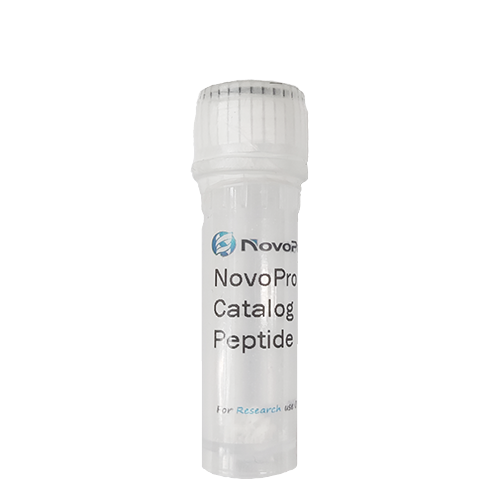Substance P (1-7) peptide
Not For Human Use, Lab Use Only.
Cat.#: 305849
Special Price 88.60 USD
-
Product Name
Substance P (1-7) peptide
-
Documents
Batch to batch variation of the purity
-
Sequence Shortening
RPKPQQF
-
Sequence
H-Arg-Pro-Lys-Pro-Gln-Gln-Phe-OH
-
Length (aa)
7
-
Peptide Purity (HPLC)
97.8%
-
Molecular Formula
C41H65N13O10
-
Molecular Weight
900.05
-
CAS No.
68060-49-1
-
Source
Synthetic
-
Form
Powder
-
Description
This amino-terminal fragment of substance P exerts depressor and bradycardic effects when applied to the nucleus tractus solitarius. It was also shown that this fragment, contrary to substance P, may reduce signs of opioid withdrawal in mice.
-
Storage Guidelines
Normally, this peptide will be delivered in lyophilized form and should be stored in a freezer at or below -20 °C. For more details, please refer to the manual: Handling and Storage of Synthetic Peptides
-
References
- M.E.Hall et al., Regul. Peptides, 46, 102 (1993)
- Q.Zhou et al., Peptides, 24, 147 (2003)
-
About TFA salt
Trifluoroacetic acid (TFA) is a common counterion from the purification process using High-Performance Liquid Chromatography (HPLC). The presence of TFA can affect the peptide's net weight, appearance, and solubility.
Impact on Net Weight: The TFA salt contributes to the total mass of the product. In most cases, the peptide content constitutes >80% of the total weight, with TFA accounting for the remainder.
Solubility: TFA salts generally enhance the solubility of peptides in aqueous solutions.
In Biological Assays: For most standard in vitro assays, the residual TFA levels do not cause interference. However, for highly sensitive cellular or biochemical studies, please be aware of its presence.
-
Molar Concentration Calculator
-
Dilution Calculator
-
Percent Concentration Calculator
Mass (g) = Concentration (mol/L) × Volume (L) × Molecular Weight (g/mol)
Peptide Property
- Analysed Sequence:H-RPKPQQF-OH
- Chemical Formula:C41H65N13O10
- Sequence length:7
- Extinction coefficient:0 M-1cm-1
- GRAVY:-2.26
- Mw average:900.03
- Theoretical pI:11.48
- Data Source:Peptide Property Calculator
GRAVY = grand average of hydropathy
X: Hydrophobic uncharged residues, like F I L M V W A and P
X: Basic residues, like R K H
X: Acidic residues, like D E
X: Polar uncharged residues, like G S T C N Q and Y
Related Products / Services
• Peptide Services: NovoPro's peptide synthesis services include standard chemical peptide synthesis, peptide modification, peptide libraries, and recombinant peptide expression.
• Standard Peptide Synthesis: NovoPro offers quality peptides at the most competitive prices in the industry, starting at $3.20 per amino acid. NovoPro provides PepBox – Automatic Quote Tool for online price calculation.
• Peptide Modifications: NovoPro offers a wide range of peptide modification services including isotope labeling (2H, 15N, and 13C), multiple disulfide bonds, multiple phosphorylations, KLH, BSA, ovalbumin, amidation, acetylation, biotin, FITC, etc.
Please note: All products are "FOR RESEARCH USE ONLY AND ARE NOT INTENDED FOR DIAGNOSTIC OR THERAPEUTIC USE"

